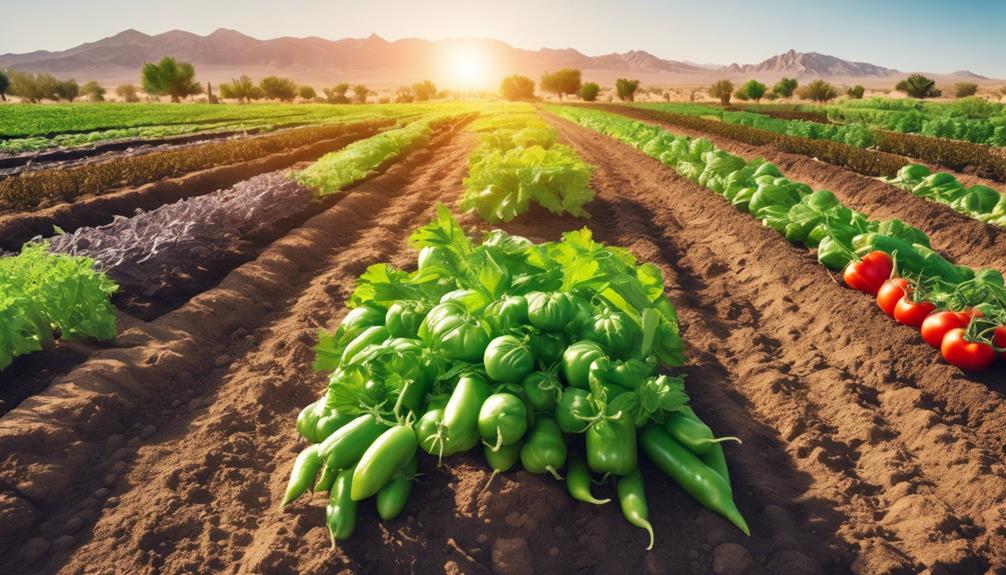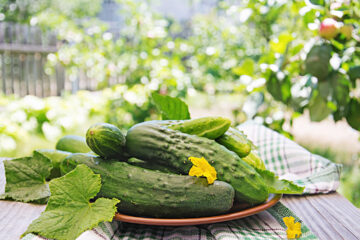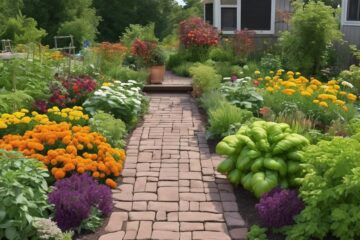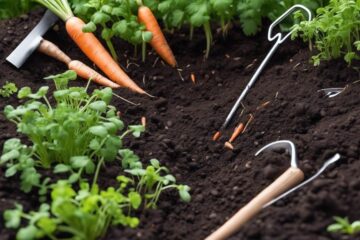Imagine a sun-parched landscape where resilient plants thrive against the odds, their leaves shimmering in the intense heat.
In such harsh conditions, certain vegetables emerge as heroes, defying the arid climate with their ability to adapt and flourish.
But which specific vegetables are these, and how can you ensure their success in your own dry garden?
Let's explore the secrets behind cultivating a verdant oasis in the midst of aridity, uncovering the best vegetable choices for your arid climate garden.
Best Vegetables for Arid Climates
When cultivating a vegetable garden in an arid climate, opt for drought-resistant varieties like tomatoes, eggplants, okra, and peppers. These vegetables are well-suited for areas with limited water availability.
Choosing plants with deep root systems is crucial for drought conditions as they can access moisture deep in the soil. By selecting vegetables that require minimal watering, you contribute to the conservation of water in arid regions.
Opting for crops like potatoes and carrots, which thrive in raised beds, can also help in water retention. Consider desert-adapted options such as sweet potatoes, chard, beets, and Sonoran White wheat for successful growth in arid climates.
Native plants like cacti, tepary beans, and basil are excellent choices that flourish with little water in these challenging environments.
Choosing Drought-Resistant Vegetables
To successfully garden in arid climates, prioritize selecting drought-resistant vegetables such as eggplants, okra, Swiss chard, root crops, and peppers due to their ability to thrive with minimal water.
Key Points:
- Water Conservation: Choosing vegetables that require less water helps in conserving this precious resource, especially in arid regions.
- Drought-Resistant Vegetables: Opt for varieties like Ping Tung Long eggplants, Becks Big Buck okra, Fordhook Giant Swiss chard, and hot Thai and bird peppers that are well-suited for dry conditions.
- Raised Beds: Consider growing root crops like potatoes and carrots in raised beds to improve water retention and yield in arid climates.
Top Veggies for Dry Climates
Consider planting Tepary beans and Sonoran White wheat for their excellent drought tolerance in arid climates. Peppers, tomatoes, and squash are also great choices for your vegetable garden in dry conditions. These veggies can thrive with minimal water, making them ideal for drought conditions.
When growing root vegetables like sweet potatoes and carrots in arid regions, ensure you use a soaker hose to provide consistent moisture. Additionally, unique crops such as cacti, dates, and olives can flourish in hot desert environments with little water.
For vegetables like chard, beets, and potatoes, success in arid climates depends on adequate watering and care. Choose wisely to enjoy a bountiful harvest from your dry climate garden.
Growing Vegetables in Arid Regions
For successful vegetable cultivation in arid regions, prioritize selecting drought-tolerant plant varieties like cowpeas, tepary beans, and tomatoes.
- Tomato Varieties: Choose heat and drought-resistant tomato varieties such as 'Sun Gold' or 'Super Sioux' for optimal growth in arid conditions.
- Amount of Water: Be mindful of the water needs of your plants; tomatoes, in particular, require consistent watering but can withstand dry spells better than other vegetables.
- Desert Gardener: As a desert gardener, focus on techniques like deep mulching and targeted irrigation to help your vegetables thrive in arid regions. Stay attentive to the unique challenges of gardening in dry climates to ensure a successful harvest.
Selecting Arid-Adapted Vegetables
When choosing vegetables for arid climates, prioritize varieties like cowpeas, tepary beans, and okra known for their resilience to hot and dry conditions. Additionally, selecting drought-resistant varieties such as Yellow Pear tomatoes and Ping Tung Long eggplants can ensure successful growth in arid regions. Root crops like sweet potatoes and beets are also suitable choices for arid climates due to their ability to withstand low water availability. To add variety to your arid garden, consider including drought-tolerant peppers like hot Thai and bird peppers. Moreover, incorporating desert-adapted crops such as Sonoran White wheat and native plants like cacti can further enhance the success of your garden in arid conditions.
| Arid-Adapted Vegetables | Drought-Resistant Varieties | Desert-Adapted Crops |
|---|---|---|
| Cowpeas | Yellow Pear tomatoes | Sonoran White wheat |
| Tepary beans | Ping Tung Long eggplants | Native cacti |
| Okra |
Frequently Asked Questions
What Vegetables Grow Best in Dry Climates?
In dry climates, you can grow a variety of vegetables like cowpeas, tomatoes, eggplants, and peppers. With proper care, mulching, and watering techniques, these plants thrive. Choose drought-resistant varieties and monitor maturity for success.
What Vegetables Grow Best in the Desert?
In the desert, vegetables like sweet potatoes and chard thrive due to their resilience in dry conditions. Raised beds with topsoil and compost can boost growth for peppers, tomatoes, and squash. Consider these options for your arid garden.
What Vegetables Are Dry Tolerant?
When growing vegetables in arid areas, focus on drought-tolerant options like cowpeas, tepary beans, lentils, and peanuts. These plants thrive with minimal water, making them ideal choices for dry climates. Consider their adaptability for successful cultivation.
What Plants Grow in an Arid Climate?
In arid climates, plants like cacti and lavender thrive. Their ability to flourish with little water makes them ideal choices for your garden. Explore the beauty of desert-adapted fruits and herbs that can prosper in such environments.
Conclusion
You've learned about the best vegetables for arid climates, like cowpeas and tomatoes.
Did you know that cowpeas can survive with only 8-12 inches of water annually?
By choosing drought-resistant varieties and following proper care techniques, you can successfully grow a thriving garden in dry regions.
Happy gardening!





